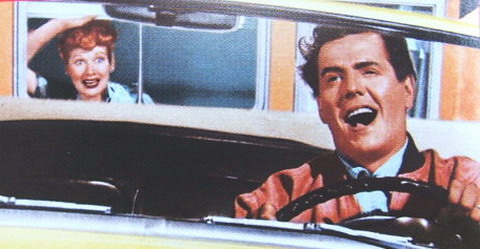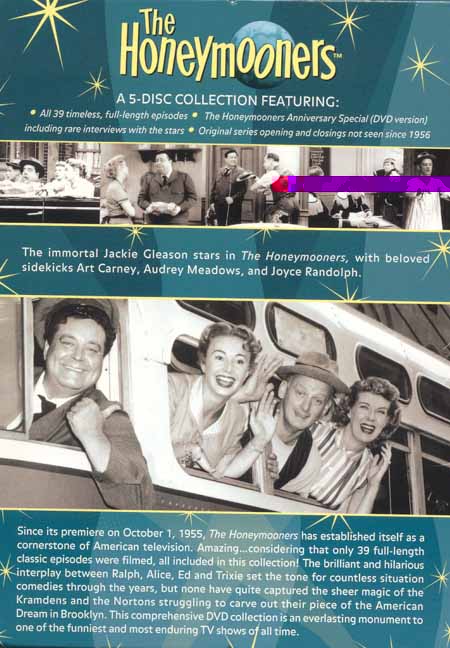This is topic "I Love Lucy" on super 8! in forum 8mm Forum at 8mm Forum.
To visit this topic, use this URL:
https://8mmforum.film-tech.com/cgi-bin/ubb/ultimatebb.cgi?ubb=get_topic;f=1;t=004310
Posted by Kurt Gardner (Member # 440) on February 03, 2009, 11:00 AM:
I won a super 8mm "I Love Lucy" episode on eBay. It's the one in which Lucy and Ethel buy a walk-in freezer and order far too much meat for it.
Just watched it last night. The quality is really quite good -- contrast, sound fidelity, etc. It's mounted on two 400' reels, split at the act break. There are a few minor jumps in the source material which leads me to believe that it was made from a 16mm syndication negative or print, but whoever did it and for what reason did a really good job. I've never heard of any other Lucys released in the format.
Posted by Steve Klare (Member # 12) on February 03, 2009, 11:42 AM:
That's really cool!
When Desi Arnaz was negotiating the deal for the series, he got two key things:
1) The shows were to be shot on 16mm instead of the early video systems because of the radical improvement in quality (This makes Desi our kind of guy!).
2) After the first run shows the negatives and rights would revert to Desilu.
CBS figured #2 wasn't worth a whole lot, but the reruns made a lot of money for a lot of years.
-shame for them nobody 'splained that before they agreed to it!
A few years later the cast of "Gilligan's Island" cut the exact opposite deal and suffered for it. They thought it was a turkey so they took more money up front instead of residuals. It played for years in reruns, they didn't get a penny and got typecast to boot!
-this is how Alan Hale ended up as a Maitre d' at a restaurant called "Skipper's" which he didn't actually own.
That never happened to either Lucy or Desi.
Posted by Tony Stucchio (Member # 519) on February 03, 2009, 05:36 PM:
Weren't most non-live 50's shows filmed rather than taped?
And weren't they done on 35mm instead of 16mm?
Posted by Steve Klare (Member # 12) on February 03, 2009, 06:07 PM:
This is what the Wikipedia article about "The Honeymooners" said.
"In 1955, most television shows were performed live and recorded using kinescope technology. One notable exception was I Love Lucy, which was recorded directly onto 35 mm film. For The Honeymooners, Gleason utilized the Electronicam TV-film system, developed by DuMont in the early 1950s."
Kinescope had a film camera filming off a video monitor, so it was video capture and broadcast, then film recording. I remember hearing 16mm for "I love Lucy", but then again you can't count on people knowing the difference.
Dumont Electronicam was interesting: the visual image was split for broadcast by a video camera and captured by a film camera too. This made for much better quality on rebroadcast since it was still first generation.
Posted by Paul Adsett (Member # 25) on February 03, 2009, 06:26 PM:
Steve, I think the very first 'Honeymooner's ' were live performances recorded by Kinescope. Thank God most of the series (in Miami Beach)was filmed live on Kodak Tri X film, and they look really great today:
http://www.theasc.com/magazine/wrap/1098wrap.htm
The Great One was a true genius of comedy as well as a superb actor ('The Hustler', 'Requiem for a Heavyweight'). Nice to know he will be around forever.
Posted by Douglas Meltzer (Member # 28) on February 03, 2009, 06:49 PM:
"I Love Lucy" was the first sitcom to shoot with three cameras, which soon became the standard. The cinematographer on "Lucy" was the brilliant Karl Freund, who shot "Metropolis", "The Last Laugh", "Dracula" and "All Quiet on the Western Front". Freund also directed Boris Karloff in "The Mummy".
"I Love Lucy" was shot in 35mm using three Mitchell BNC (Blimped Newsreel Camera) cameras.
Doug
Posted by Steve Klare (Member # 12) on February 03, 2009, 07:04 PM:
Yes, I've seen some of those early Honeymooners, which were basically a skit in the "Jackie Gleason Show". They look awful.
Jackie Gleason was a genius, and there was a lot more to him than Ralph Kramden. What a lot of people don't know about him was he was very talented musically: he composed quite a bit of orchestral music and released several albums.
Posted by Kurt Gardner (Member # 440) on February 03, 2009, 09:26 PM:
Within 20 minutes of my posting a positive response on eBay, he sent me an email offering uncut network prints on DVD. Anyone interested? I just thought the super 8mm was cool.
Posted by Jim Carlile (Member # 812) on February 04, 2009, 12:19 AM:
Well, some corrections are in order. 'Lucy' was shot in 35mm, but the syndication prints were in 16mm. Alan Hale did indeed own his restaurant on La Cienaga Blvd., called 'The Lobster Barrel' back when that whole area was known as 'Restaurant Row' (Lawry's is still there-- the last of the old timers.)
Gleason's original 'Honeymooners' with Pert Kelton (before she was blacklisted) were kinescopes off the tube, a few of the Audrey Meadows snippets are too, but the half-hour ones we all know are in 35mm. They were pre-recorded like movies, not live, but all in one piece, and in New York City, too, in 1955-- the move to Miami Beach was later, about 63-64.
http://www.geocities.com/rmm413/Honeymooners.html
It is a trip that Karl Freund was Lucy's first DP, and later the great Sid Hickox, another classic Warner Brothers lensman ('The Big Sleep,' etc. etc.)
Ah, the days when age was venerated. And it showed, too.
Posted by Graham Ritchie (Member # 559) on February 04, 2009, 12:45 PM:
For fans of Lucille Ball look out for CBS Salutes Lucy The First 25 Years made in 1976. Region 1 DVD. it has quite a line up of cast and stars of the time and plenty of extracts from "I Love Lucy", "Here's Lucy" and "The Lucy Show".
Years ago I had a B/W 16mm print "The Long Long Trailer" made in 1954 starring Lucille Ball and Desi Arnez, a very funny movie, ![[Smile]](smile.gif) well worth looking out for a good colour print if you can find one, also available Region 1 DVD, highly recommend in either form.
well worth looking out for a good colour print if you can find one, also available Region 1 DVD, highly recommend in either form.

"The Long Long Trailer" was a 32-foot-long 1953 New Moon weighing more than 3 tons.
Graham.
Posted by Steve Klare (Member # 12) on February 04, 2009, 01:15 PM:
I know this movie well! When Desi gets in the driver's seat with trailer astern and drives away for the first time he narrates "I wasn't sure if I was pulling it or it was pushing me!"
A couple of years back when my wife decided she's had enough of camping in a tent and somehow maneuvered us into a trailer I thought about this moment a great deal...
Interesting that when you fly they often go through the in-flight feature and maybe some news, and that should be enough to get you there, but they often tack on a "Honeymooners" or "I love Lucy" at the end. I guess they figure most people like these and they are so familiar that if they have to cut it off ten minutes from the end to land it's no big deal: you've seen the ending a hundred times anyway. At the same time you don't mind seeing that same episode the hundred and first time either.
Posted by Tony Stucchio (Member # 519) on February 04, 2009, 05:51 PM:
My point was "non-live" TV shows -- I don't think they were ever done on anything but film in the 1950s. Kinescopes were for live broadcasts.
And I disagree about the "Classic 39" Honeymooners episodes from 1955/56. They were never broadcast live, as implied in the article in the link.
Posted by Jim Carlile (Member # 812) on February 04, 2009, 09:43 PM:
I think the article says they were not broadcast live, but performed live in front of a real audience. I heard Audrey Meadows once mention that they did it all intact, like a stage play. Almost 40 episodes that year, one after another. Lucy the same thing-- in that case they would do two complete shows back-to-back, and intercut them for the release print.
Posted by Tony Stucchio (Member # 519) on February 05, 2009, 06:30 PM:
It says:
quote:
The video material was transmitted live to a control room where the director selected edits and camera angles, much in the same manner employed today on three-camera newscasts.
The director's video editing choices were later fed into kinescope equipment to create a "teletranscription" — a blueprint of how the program appeared during broadcast. The teletranscription was then synchronized to the 35mm film reels that were sent off for editing. The archival film versions of each episode — shot on Kodak's Tri-X stock — were later used for delayed broadcasts and reruns.
The use of the words "live", and "a blueprint of how the program appeared during broadcast", implies a live broadcast. I checked one of my old Honeymooners books, and it is clear that they were never broadcast live -- the "Classic 39", that is.
Steve states:
quote:
Dumont Electronicam was interesting: the visual image was split for broadcast by a video camera and captured by a film camera too. This made for much better quality on rebroadcast since it was still first generation.
With all due respect, Steve, that is not true regarding the broadcast. Unless, of course, another show used Dumont Electronicam, and that it what you are saying. But not for the Honeymooners.
Posted by Paul Adsett (Member # 25) on March 07, 2009, 10:09 AM:
I do not normally collect TV shows, but I made an exception with 'The Honeymooners' and purchased the Classic 39 episode collection a couple of days ago. What a revelation! If you have only seen 'The Honeymooners' on TV, this package is a real eye opener, with pin sharp picture quality and gorgeous black and white contrast. Paramount have done a wonderful restoration job. Shown on a video projector in a darkened room, these shows are shear joy to watch. Thank God for Dumont's Electronicam system that simultaneously filmed these shows through a beam-splitter on the TV camera.
The comedy of The Kramden's is truly timeless and 'The Honeymooners' is today more popular than ever.
I wonder if 'The Honeymooners' was ever showed in the UK, and if so how well it was received.

Visit www.film-tech.com for free equipment manual downloads. Copyright 2003-2019 Film-Tech Cinema Systems LLC

UBB.classicTM
6.3.1.2
![[Smile]](smile.gif) well worth looking out for a good colour print if you can find one, also available Region 1 DVD, highly recommend in either form.
well worth looking out for a good colour print if you can find one, also available Region 1 DVD, highly recommend in either form.
